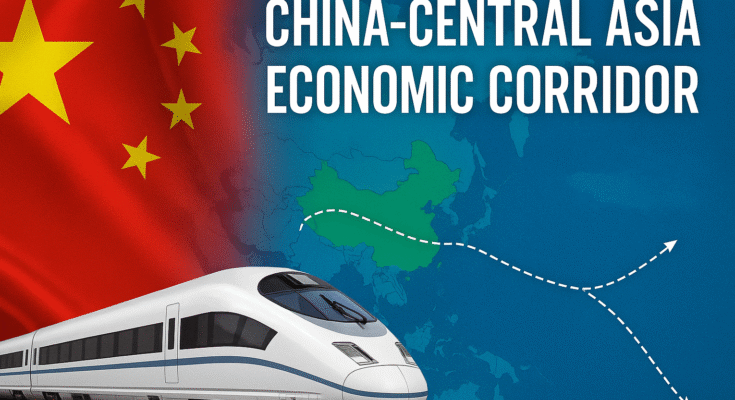Introduction
China is known for its strategic mega-projects, and in 2025, the spotlight is shifting to one of its most ambitious undertakings: the China-Central Asia Economic Corridor. This emerging trade route, poised to reshape global supply chains, is part of the evolving Belt and Road Initiative (BRI). The corridor aims to strengthen China’s trade relations with Central Asian nations while reducing dependency on traditional shipping lanes like the South China Sea and Suez Canal.
In this article, we’ll explore the vision, components, strategic benefits, and future prospects of the China-Central Asia Economic Corridor, a project set to transform global commerce.
What is the China-Central Asia Economic Corridor?
The China-Central Asia Economic Corridor is a multi-nation infrastructure and trade initiative focused on connecting China with Kazakhstan, Kyrgyzstan, Uzbekistan, Turkmenistan, and potentially Iran, Azerbaijan, and Turkey. It involves building and expanding:
- High-speed rail networks
- Highways
- Oil and gas pipelines
- Dry ports and logistics hubs
- Optical fiber connectivity
The goal is to establish a seamless and efficient overland trade route between China and Europe via Central Asia, bypassing geopolitical bottlenecks like Russia and maritime routes prone to disruptions.
Strategic Objectives Behind the Project
1. Reducing Trade Dependency on Russia and Maritime Routes
One of the key motivations behind the China-Central Asia Economic Corridor is China’s aim to diversify its trade routes. Recent global tensions, especially with Western countries and supply chain disruptions in maritime channels, have pushed China to seek alternative overland pathways.
2. Enhancing Belt and Road 2.0 Vision
This corridor is considered part of the next phase of the Belt and Road Initiative (BRI 2.0). It focuses more on digital connectivity, green infrastructure, and inclusive partnerships, in contrast to the heavy infrastructure-driven first phase of BRI.
3. Securing Energy and Resource Flows
Central Asia is rich in oil, gas, and minerals. By strengthening its logistic and pipeline infrastructure in the region, China ensures a steady flow of energy resources for its growing industrial needs.
Major Components of the Corridor
1. High-Speed Railway Lines
China is investing in high-speed railways connecting Urumqi (Xinjiang) with major Central Asian cities like Almaty, Bishkek, and Tashkent. These trains are intended to reduce cargo transit time significantly — from weeks to mere days.
2. Digital Silk Road
The corridor is not just about physical goods. It will also carry data. China plans to install optical fiber networks and 5G infrastructure along the route, making Central Asia a part of its “Digital Silk Road.”
3. Pipelines and Energy Infrastructure
Several pipelines already exist between China and Central Asia. The corridor will expand these, including oil pipelines from Kazakhstan and gas pipelines from Turkmenistan. This ensures energy security while boosting Central Asian economies.
4. Logistics and Dry Ports
Dry ports such as the Khorgos Gateway are being expanded to handle higher volumes of freight. These ports will act as major hubs where goods can be inspected, stored, and redirected efficiently.
Economic Benefits for Central Asia
The China-Central Asia Economic Corridor is not a one-sided affair. It holds significant promise for Central Asian nations as well:
- Job Creation: Infrastructure development creates employment in construction, logistics, and IT sectors.
- Technology Transfer: Chinese partnerships often bring modern technology and expertise to the host country.
- Boost to Local Exports: With better roads and railways, Central Asian countries can access Chinese and European markets more efficiently.
- Tourism and Cultural Exchange: Improved connectivity encourages people-to-people ties and tourism growth.
Challenges and Concerns
Despite its vast potential, the China-Central Asia Economic Corridor is not without challenges.
1. Geopolitical Tensions
Some Western countries see this as a strategic expansion of China’s influence. This may lead to political resistance and pressure on Central Asian countries.
2. Debt Dependency
Critics warn about the “debt-trap diplomacy” concern. Countries taking Chinese loans for infrastructure may face repayment issues in the long run.
3. Environmental Impact
Large-scale infrastructure projects often come with ecological costs. Deforestation, water usage, and carbon emissions are all areas of concern.
Integration with Europe and the Middle East
One of the most exciting aspects of the China-Central Asia Economic Corridor is its potential to connect beyond Central Asia:
- Through the Trans-Caspian International Transport Route, goods can reach Azerbaijan, Georgia, and ultimately Europe.
- Iran can serve as a gateway to the Middle East and Turkey, connecting the corridor to the Mediterranean.
This transforms the corridor from a regional initiative into a transcontinental trade artery.
China’s Digital and Green Agenda in the Corridor
China has emphasized that BRI 2.0 — and particularly this corridor — will focus more on:
- Green energy projects like solar and wind installations
- Smart city infrastructure
- Digital e-commerce platforms that connect producers in Central Asia with consumers in China and Europe
This makes the corridor future-ready and aligned with sustainable development goals.
Latest Developments (2025)
As of May 2025:
- A joint declaration is expected between China and Central Asian nations at the upcoming Shanghai Cooperation Organization (SCO) Summit.
- Pilot freight trains have already begun test runs on new routes between Xinjiang and Tashkent.
- Funding partnerships are being finalized with the Asian Infrastructure Investment Bank (AIIB) and regional development funds.
These indicators show that the corridor is not just theoretical — it is becoming a reality.
Conclusion
The China-Central Asia Economic Corridor represents more than just a set of railways and roads. It is a symbol of a new world order in trade, where overland routes rival maritime dominance and regional cooperation overcomes geopolitical barriers.
As China continues to strengthen its strategic presence in Central Asia, this corridor could become a model for sustainable, digitally connected, and inclusive infrastructure development. For investors, governments, and global citizens, this corridor is one to watch.
FAQs
Q1: What is the purpose of the China-Central Asia Economic Corridor?
It aims to enhance trade connectivity between China and Central Asia through transport, energy, and digital infrastructure.
Q2: Which countries are involved in this project?
Primarily China, Kazakhstan, Uzbekistan, Kyrgyzstan, Turkmenistan, with possible links to Iran, Azerbaijan, and Turkey.
Q3: How does this project fit into the Belt and Road Initiative?
It is a key part of BRI’s second phase, focusing on sustainable and digital development.
Q4: When will the corridor be fully operational?
Initial phases are active, with full-scale operations expected by 2027, depending on regional agreements.




